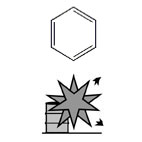| Case Name |
Explosion of benzene used as washing oil during cleaning a fuel oil tank |
| Pictograph |

|
| Date |
January 29, 1996 |
| Place |
Yokkaichi, Mie, Japan |
| Location |
Chemical factory |
| Overview |
When a fuel tank was opened, workers cleaned a heating steam coil in the tank with benzene. After cleaning, remaining benzene in the tank exploded. Why was a cleaning method by hand using benzene adopted, though the hazardous properties of benzene were well known? It was also doubtful whether the cleaning workers got education or were aware of the hazards of benzene. |
| Incident |
After cleaning a heating steam coil in a fuel tank, benzene used for cleaning that remained in the tank ignited and exploded. |
| Processing |
Storage |
| Substance |
Benzene, Fig2 |
| Type of Accident |
Explosion |
| Sequence |
08:30 on January 29th, 1996; there was a meeting about the work of that day.
09:40; two workers went inside the tank and soaked a waste cloth in benzene in a bucket. They cleaned a steam coil. The workers rotated several times.
About 14:00; cleaning was completed. They drew off remaining benzene through a drain valve into a bucket. Then they transferred it using a pneumatic pump to an empty 200 L drum. The pump failed, and while they were preparing to repair the pump, an explosion occurred inside the tank. |
| Cause |
It was considered that remaining benzene at the bottom of the tank generated a combustible gas-air mixture due to insufficient ventilation. The connection of a projector being used in the tank or of a code reel was thought to be the ignition source of a fire. |
| Response |
Workers extinguished burning clothes of colleagues. |
| Countermeasures |
Prohibition of the use of benzene for cleaning. Execution of forced ventilation. Using explosion-proof electrical equipment, and preparing a system for unusual work. |
| Knowledge Comment |
Accidents often happen during unusual work. |
| Background |
The following were the causes; The use of highly flammable benzene. Insufficient forced ventilation. The use of non-explosion-proof electric equipment. An insufficient check system for unusual operations. |
| Incidental Discussion |
There was no description about the countermeasures against a benzene explosion in the guideline for cleaning inside of a tank. |
| Reason for Adding to DB |
Example of the explosion caused due to inadequate cleaning methods |
| Scenario |
| Primary Scenario
|
Poor Value Perception, Poor Safety Awareness, Inadequate Risk Recognition, Insufficient Analysis or Research, Insufficient Practice, No Imagination, Ignorance, Insufficient Knowledge, Insuficient Study and Experience, Planning and Design, Poor Planning, Poor Planning of Repair, Usage, Maintenance/Repair, Cleaning, Secondary Damage, External Damage, Explosion, Bodily Harm, Injury, 1 person injured
|
|
| Sources |
Japan Industrial Safety and Health Association, Details of accident occurrences
Fire and Disaster Management Agency, Explosion when cleaning outdoor tank, accident cases of dangerous materials.1996, pp.146-147
Japan Industrial Safety and Health Association. Information Center for Safety and Health, Example of labor accident. No.100130, Japan Industrial Safety and Health Association's home page
|
| Number of Deaths |
1 |
| Number of Injuries |
1 |
| Physical Damage |
The tank's roof and the upper side wall were damaged. |
| Multimedia Files |
Fig2.Chemicalformula
|
| Field |
Chemicals and Plants
|
| Author |
WADA, Yuji (National Institute of Advanced Industrial Science and Technology)
TAMURA, Masamitsu (Center for Risk Management and Safety Sciences, Yokohama National University)
|